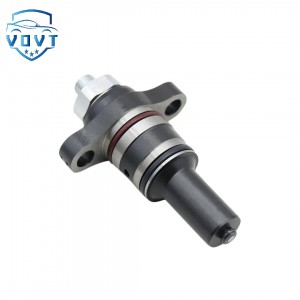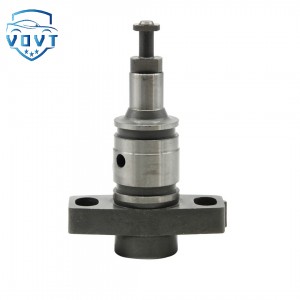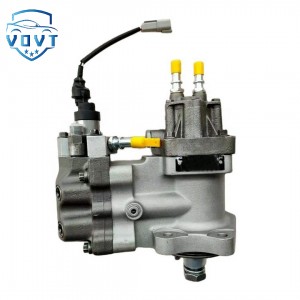High Quality Head Rotor 1 468 376 017 Pump Parts 1468376017 Diesel Engine Parts Auto Engine Parts
products description
| Reference. Codes | 1 468 376 017 |
| Application | / |
| MOQ | 2PCS |
| Certification | ISO9001 |
| Place of Origin | China |
| Packaging | Neutral packing |
| Quality Control | 100% tested before shipment |
| Lead time | 7~15 working days |
| Payment | T/T, L/C, Paypal, Western Union or as your requirement |
Head Rotor Introduction
Basic structure and core components of pump head
The structure of the pump head varies slightly depending on the type of fuel system (such as plunger injection pump, distribution pump, high-pressure common rail pump), but the core functional units are similar, mainly including:
Pressure element
It is the "heart" of the pump head, which pressurizes the low-pressure fuel through mechanical movement. Common forms are:
Plunger pair (plunger + plunger sleeve): The plunger reciprocates in the plunger sleeve, compresses the fuel through the closed volume change, and generates high pressure (plunger stroke and diameter determine displacement and pressure);
Gear/vane pump core: In the low-pressure fuel supply stage (such as the low-pressure end of the common rail pump), the initial pressure (usually 10-20bar) is generated by gear meshing or blade rotation to supply fuel to the high-pressure part;
High-pressure plunger assembly (special for common rail pump): Multiple plungers (2-4) work alternately, continuously output high-pressure fuel (up to 2000bar or more), and maintain stable pressure in the common rail pipe.
Control and adjustment components
Used to control the fuel supply, fuel supply timing and pressure, including:
Oil outlet valve pair: prevent high-pressure fuel from flowing back, ensure that the pressure drops quickly at the end of fuel supply, and avoid injector dripping;
Speed governor connection mechanism: through the pull rod, fork, etc., it is linked with the speed governor to adjust the effective stroke of the plunger according to the engine working conditions (speed, load) and change the fuel supply;
Timing adjustment device: such as eccentric shaft and roller body, by changing the moment when the plunger starts to pressurize, adjust the fuel supply advance angle (affecting combustion efficiency).
Auxiliary structure
Includes pump body (carrying various components, need to be resistant to high pressure and vibration), oil inlet (connected to low-pressure oil circuit), oil outlet (connected to high-pressure oil pipe or common rail pipe), lubricating oil channel (lubricating plunger and other moving parts), etc.
Classification of pump head (by application scenario)
Plunger injection pump pump head
Common in traditional diesel engines (such as inline pumps), each cylinder corresponds to a set of plunger pairs, and the pump head drives the plunger to reciprocate through the camshaft, and supplies oil in sequence according to the cylinder sequence.
Features: simple structure, low cost, but low pressure (usually ≤1000bar), and the fuel supply accuracy is greatly affected by the speed.
Distribution pump head
Used for distribution injection pumps (such as VE pumps), the single plunger completes fuel pressurization and cylinder distribution at the same time through rotation and reciprocating motion, suitable for small-displacement diesel engines.
Features: small size and light weight, but limited high-pressure performance (≤1200bar), and high maintenance difficulty.
High-pressure common rail pump head
It is the "high-pressure source" of the common rail system. Through the high-speed operation of multiple plungers (such as 3 plungers for Bosch CP3 pump), the fuel is pressurized to 1600-2500bar and then sent to the common rail pipe, and then distributed to each injector by the common rail pipe.
Features: high pressure, continuous and stable fuel supply, the pressure can be accurately controlled by the electronic control unit (ECU), adapted to the emission requirements of National VI and above, and is the mainstream configuration of modern diesel engines.
Core functions of the pump head
Fuel pressurization
The low-pressure fuel (about 0.5-5bar) delivered from the fuel tank is pressurized to high pressure (500-2500bar according to the system type) to meet the pressure conditions required for injector atomization (the higher the pressure, the finer the atomization and the more complete the combustion).
Quantitative fuel supply
According to the engine load (such as the throttle opening), by adjusting the effective stroke of the plunger (or the flow control valve of the common rail pump), the fuel supply per unit time is accurately controlled to ensure the matching power of the engine output.
Timed fuel supply
The start time of fuel pressurization is controlled by the timing mechanism (such as camshaft phase, roller body height) to ensure that the injector sprays fuel before the piston reaches a specific position (such as before the compression top dead center) to optimize combustion efficiency.
Stable pressure output
The common rail pump head also needs to cooperate with the pressure sensor and flow valve to adjust the fuel supply in real time, maintain the stability of the pressure in the common rail pipe (not affected by the engine speed fluctuation), and realize flexible injection (pre-injection, main injection, and post-injection).
Key features and maintenance requirements of the pump head
Material and processing accuracy
Core components (plunger, plunger sleeve, oil outlet valve) need to be made of high-strength alloy (such as chromium tungsten manganese steel) and precision-processed (fit clearance ≤ 0.003mm) to withstand high pressure and high-frequency friction (plunger reciprocating frequency can reach thousands of times/minute).
Sealing
The sealing surfaces (conical or flat) of the plunger pair and the oil outlet valve need to be strictly sealed, otherwise it will cause fuel leakage, pressure drop, insufficient fuel supply, and engine power attenuation.
Maintenance points
Regularly replace the fuel filter to prevent impurities from entering the pump head and wearing the pair;
Replace the lubricating oil according to the specifications to ensure lubrication of the plunger and other parts;
If there are faults such as unstable fuel supply, insufficient pressure, abnormal noise, etc., it is necessary to check the plunger wear, oil outlet valve sealing or timing mechanism. In severe cases, the pump head assembly needs to be replaced (the pair is usually a precision matching part and cannot be replaced separately).



























